Colored Gemstones:
the “4 Cs” & Other Considerations
How are colored gems valued? Are the same criteria used as for diamonds? Can any jeweler appraise colored gems? What should insurers watch out for?
Colored gems is a phrase that includes about sixty varieties of mineral suitable for jewelry. There are also a few organic materials used in jewelry, such as coral, amber and pearl. They are all judged by the “4Cs”: Color, Clarity, Cut, and Carat weight.
Color
For colored gems, the most important determinant of value is their color.
Tone, Saturation, Hue
A color "grade" is not simply a place on a scale but a set of precise descriptive terms. The gemologist grades in terms of tone (the lightness or darkness of a color), saturation (the intensity of a color, or the degree to which a color departs from neutral or gray), and hue (using the Color Stone Grading System, which specifies 31 hues). An emerald's color, for example, might be described as "Medium Light" tone, "Very Slightly Grayish" saturation, and "very slightly bluish Green" hue.
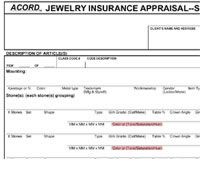 Too
often, appraisals contain only brief and vague descriptions of color, as though
it didn't much matter. However, the gemological terms for gem color are standardized
and specific. Appraisals should always describe color in terms of tone, saturation
and hue, as on ACORD 78/79. (click the image to see a full-sized pdf in
a new window).
Too
often, appraisals contain only brief and vague descriptions of color, as though
it didn't much matter. However, the gemological terms for gem color are standardized
and specific. Appraisals should always describe color in terms of tone, saturation
and hue, as on ACORD 78/79. (click the image to see a full-sized pdf in
a new window).
Phenomena
 Some
color gems have characteristics called phenomena that enhance their beauty
and value. One of these is chatoyancy, or cat’s eye.
Some
color gems have characteristics called phenomena that enhance their beauty
and value. One of these is chatoyancy, or cat’s eye.
Clarity
Clarity is the term used to describe the internal quality of a gem. The appraiser examines the gem for inclusions, cracks, cavities, clouds, or other imperfections.
The Gemological Institute of America recognizes 8 levels for clarity. The scale applies to all gems, but the definition of each grade varies by gem type and greatly affects price.
For example, a moderately included one-carat emerald retails for about $2,000, while a one-carat aquamarine stone only slightly included (that is, of a higher clarity grade) retails for only $200.
Clarity Enhancement
Because gems of high clarity are rare and expensive, gem suppliers have developed a number of treatments for improving the appearance of lower-quality stones. One of the most widely used is fracture filling, in which cracks in the gem are filled with a non-gem material to make them less visible.
Clarity treatments, or enhancements, merely disguise the flaws in the stone,
they do not remove them. What began as a low-quality gem remains a low-quality
gem. And a gem with severe fractures, whether or not they are visible, is
more vulnerable to chipping or cracking.
Clarity treatments should be disclosed to the buyer before the sale
and they should be disclosed on the appraisal. (If a gem is UNtreated,
that should be specifically stated on the appraisal). The value of a gem is
based on its quality rather than on its appearance to the naked eye.
You may want to look over information on emerald treatments, ruby treatments and sapphire treatments. Being acquainted with the terminology will help you in discussions with jewelers.
Cut
Colored gemstones are cut to best show their color. For many richly colored stones, a smooth rounded shape or a flat polished surface does this best.
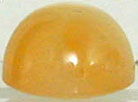 |
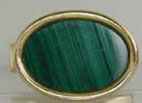 |
moonstone |
malachite |
Transparent gems are usually faceted to show them to best advantage.
 |
 |
garnet |
amethyst |
There are a number of shapes for faceted stones, but shape should not be confused with cut.
Cut Porportions
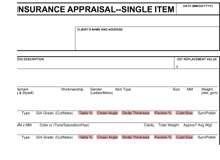 Cut
proportions — cut, for short — determine how light reflects
and refracts on the faces of the stone, and returns to the viewer’s
eye. These cut proportions — table percentage, crown angle and
pavilion percentage — should appear on the appraisal (click
the image to see a full-sized pdf in a new window).
Cut
proportions — cut, for short — determine how light reflects
and refracts on the faces of the stone, and returns to the viewer’s
eye. These cut proportions — table percentage, crown angle and
pavilion percentage — should appear on the appraisal (click
the image to see a full-sized pdf in a new window).
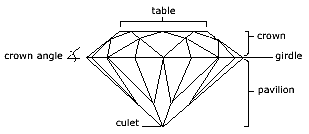
Toughness
Toughness refers to the ability of a gem to resist breakage, as from a blow or fall. Ruby and sapphire have a toughness rating of excellent, but emerald’s rating is only fair to poor. This means emerald is more vulnerable to damage, and that cut proportions are especially important. If the girdle is too thin, the gem is more likely to chip.
Carat Weight
This is the “C” that buyers are most familiar with, but more weight is not necessarily better. As we just mentioned, good proportions have more value than mere weight.
It is also worth noting that raw weight, in itself, is not necessarily valuable. A number of scams have been based on insuring large amounts of rough mineral material at greatly inflated values. The material then goes missing and the insurer is caught paying out as though gem material were, indeed, high quality gems.
Important Considerations
Not every jeweler who appraises diamonds is competent to appraise colored gemstones. It’s important that the appraiser be familiar with colored gems, and experienced in handling them so as to be able to recognize and describe their subtleties of color and phenomena. Some gems are close in appearance but very different in qualities, requiring an expert’s eye to distinguish them. The appraiser should also be engaged in buying and selling colored gems so he is familiar with the market and its price fluctuations.
Synthetics and look-alikes for colored gems are a danger. Some substitutions have been around since the 17th century. In modern times, lab-made gems have invaded the market, often without proper disclosure.
All these circumstances mean it’s very important to know you’re dealing with an honest and competent jewelry professional when pricing a repair or replacement.
FOR AGENTS & UNDERWRITERS
Check the appraisal for specific information on tone, saturation and hue. These are most important in determining the value of colored gemstones.
For faceted gems, check that the appraisal lists cut proportions (especially table percentage, crown angle, pavilion percentage).
Consider whether to insure against breakage gems that are particularly fragile, such as opal or highly included emerald.
For jewelry valued at $25,000 or more, get a second appraisal. Be sure the appraiser is experienced in dealing with colored gemstones.
FOR ADJUSTERS
In damage claims, have the jewelry examined by a jewelry professional working on your behalf to verify the jewelry’s quality and the truth of the appraisal. He might find, for example, that the stone was treated and the treatment broke down (damage for which the insurer is not liable).
For loss claims, carefully read the appraisal for mention of such terms as treatment, clarity enhancement, or fracture filling. These would suggest a lower-quality stone, perhaps with a significantly lower valuation than listed on the appraisal.
Be sure the jeweler examining a damaged stone or pricing a replacement has experience in dealing with colored stones. He should also be a graduate gemologist and a Certified Insurance Appraiser™.
©2000-2025, JCRS Inland Marine Solutions, Inc. All Rights Reserved. www.jcrs.com

